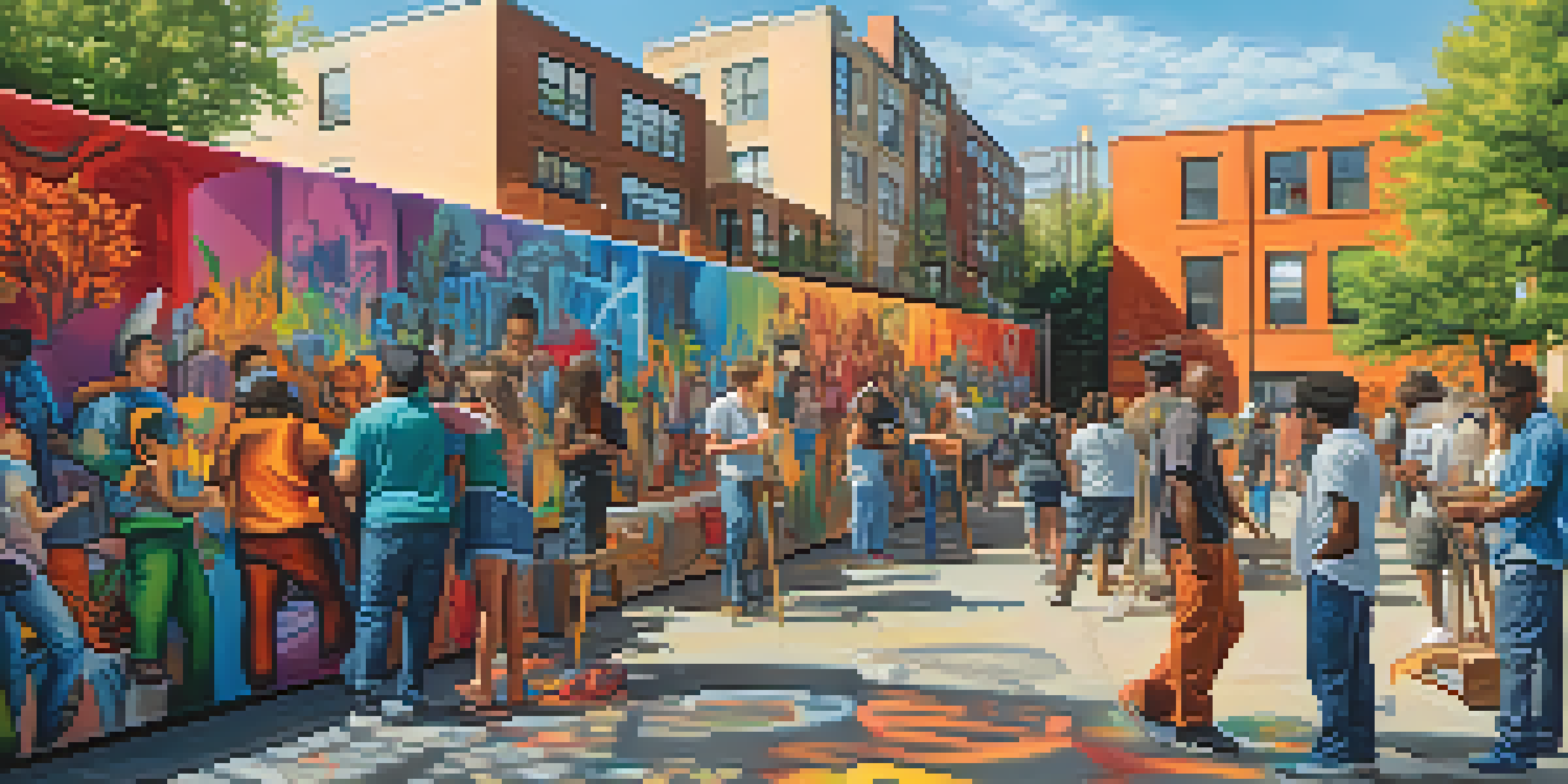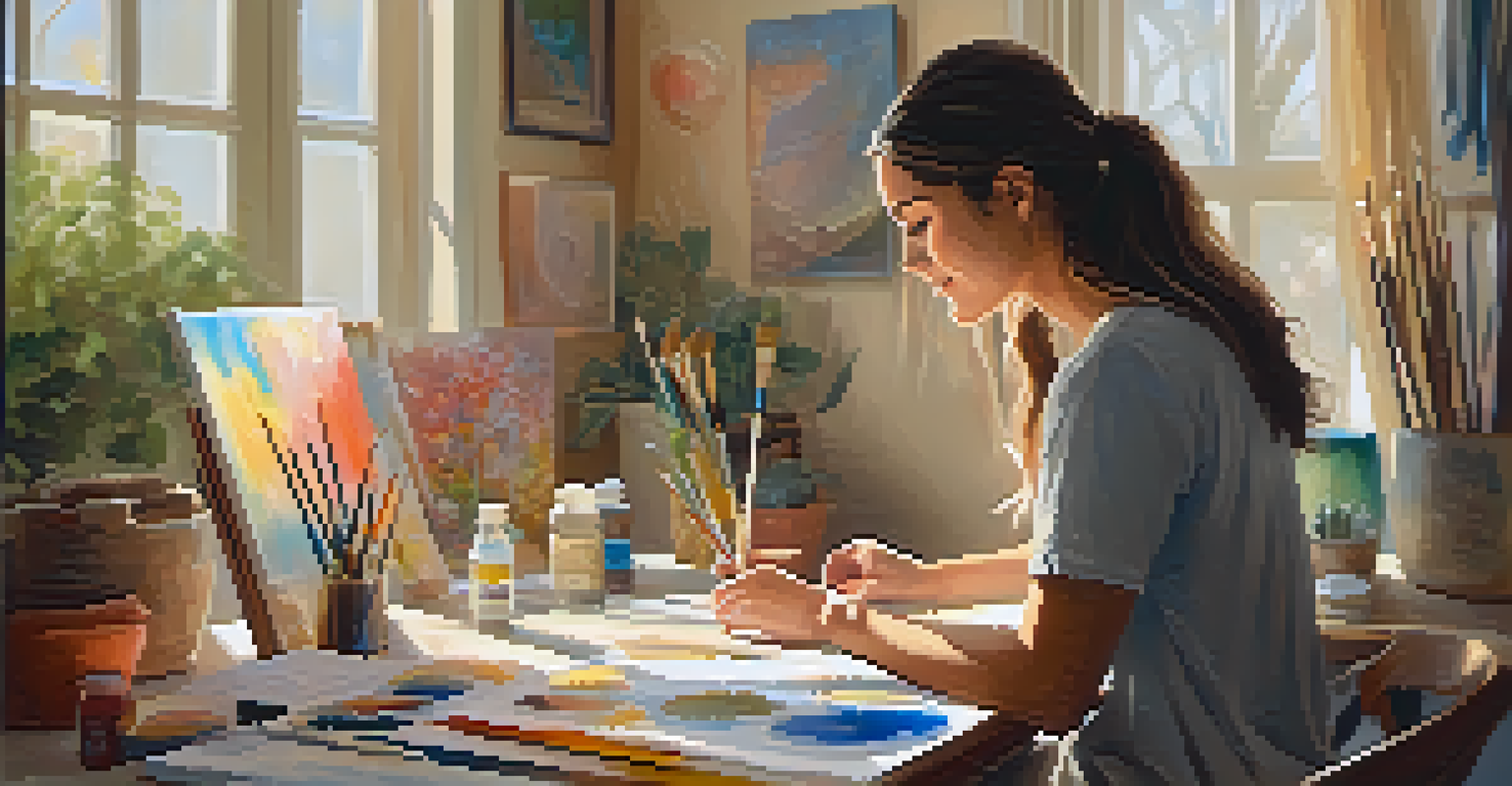Art as a Mirror: Reflecting Societal Emotions Through Visuals

Understanding Art as a Reflective Medium
Art has long been considered a mirror that reflects the emotions and values of society. From the vibrant colors of Van Gogh to the somber tones of Picasso, each piece tells a story that resonates with the viewer. This connection between art and societal emotions allows us to see our own feelings and experiences echoed in the work of artists.
Art is not freedom from discipline, but disciplined freedom.
When we look at a painting, we often find ourselves drawn to the emotions it evokes. This is not merely coincidence; artists intentionally capture the essence of their time, using their work to comment on social issues, political climates, and personal struggles. For instance, the stark imagery of wartime art can evoke feelings of loss and resilience, making the viewer reflect on their own experiences.
As we engage with art, we often find that it helps us process our emotions and understand our place in the world. This relationship between art and societal emotions serves as a reminder that creativity can be a powerful tool for reflection and healing.
The Role of Artists in Society
Artists often take on the role of commentators, using their work to provoke thought and inspire change. They have the unique ability to distill complex emotions and experiences into visual forms that resonate with a wide audience. This is evident in the works of contemporary artists who tackle issues such as climate change, inequality, and identity.

For example, Banksy's street art serves as a powerful critique of modern society. His thought-provoking pieces invite viewers to confront uncomfortable truths about consumerism and politics. In this way, artists can act as both mirrors and catalysts, reflecting societal issues while also encouraging dialogue and action.
Art Reflects Societal Emotions
Art serves as a mirror, capturing and expressing the complex emotions and values of society, which helps viewers connect their own experiences to broader cultural narratives.
Moreover, artists often draw from their own experiences, making their work deeply personal yet universally relatable. This blend of personal and societal storytelling enriches the cultural landscape, allowing audiences to explore their own feelings and thoughts through the lens of art.
Historical Context: Art Movements and Social Change
Throughout history, various art movements have emerged in response to societal changes and upheavals. The Impressionist movement, for example, arose in the context of rapid industrialization in the late 19th century. Artists sought to capture the fleeting moments of life, reflecting the changing nature of society and the human experience.
Every artist dips his brush in his own soul, and paints his own nature into his pictures.
Similarly, the Harlem Renaissance was a cultural movement that celebrated African American identity and creativity during a time of racial inequality. Artists, writers, and musicians used their talents to challenge stereotypes and express the richness of their culture. This period demonstrates how art can serve as a powerful voice for marginalized communities, reflecting their struggles and triumphs.
These historical examples remind us that art is not created in a vacuum; it is deeply intertwined with the cultural, political, and social landscape of its time. As we study these movements, we gain insight into how art mirrors societal emotions and fosters change.
Emotions Captured in Modern Art
In today's world, modern art continues to reflect the complex emotions experienced by individuals and communities. Artists are exploring themes such as anxiety, isolation, and hope, resonating with a generation grappling with rapid change and uncertainty. The use of mixed media, installations, and digital art allows for innovative expressions of these emotions.
For example, contemporary artists like Yayoi Kusama use immersive installations to evoke feelings of infinity and connection, inviting viewers to confront their own emotional landscapes. By enveloping audiences in her art, Kusama creates a shared experience that fosters reflection and dialogue.
Artists as Catalysts for Change
Artists often use their work to provoke thought and inspire social change, addressing pressing issues like inequality and climate change through relatable and accessible visual forms.
Moreover, the rise of social media has transformed how we engage with art. Artists can now share their work with a global audience, amplifying their messages and connecting with others who share similar experiences. This democratization of art allows for a greater diversity of voices and emotions to be reflected in the artistic landscape.
The Therapeutic Power of Art
Art is not just a reflection of societal emotions; it also has the power to heal and transform. Creative expression can be a therapeutic outlet for individuals struggling with mental health issues, providing a safe space to explore their feelings. Many art therapists use this principle to help clients process trauma and navigate complex emotions.
For instance, creating art can serve as a form of mindfulness, allowing individuals to focus on the present moment and escape from their daily stressors. Engaging in artistic activities fosters a sense of accomplishment and boosts self-esteem, empowering individuals to express themselves in unique ways.
Furthermore, community art projects can bring people together, fostering a sense of belonging and collective healing. By participating in these initiatives, individuals can share their stories and emotions, creating a tapestry of experiences that reflect the community's identity. In this way, art becomes a powerful tool for connection and understanding.
Art and Social Movements: A Call to Action
Throughout history, art has played a crucial role in social movements, serving as a rallying cry for change. From the vivid posters of the civil rights movement to the powerful imagery of climate activism, art has the ability to inspire action and unite people around a common cause. Visuals can captivate attention and convey messages in ways that words alone often cannot.
For example, the iconic image of the raised fist has become a symbol of solidarity and resistance against oppression. Such visuals resonate with individuals, evoking emotions and prompting them to reflect on their role in the fight for justice. This emotional connection can mobilize people to take action, whether through protests, donations, or advocacy.
Art's Healing and Community Power
Creative expression not only reflects societal feelings but also acts as a therapeutic outlet, fostering connection and understanding within communities through shared artistic experiences.
Moreover, social media has amplified the reach of artistic expressions, allowing them to spread rapidly and inspire movements worldwide. The hashtag campaigns that accompany powerful visuals create a sense of community and shared purpose, proving that art can be a catalyst for societal change.
The Future of Art in Reflecting Society
As we look to the future, the relationship between art and society will continue to evolve. With advancements in technology and changing cultural dynamics, artists are finding new ways to express emotions and reflect societal values. Virtual reality, augmented reality, and interactive installations are just a few examples of how art can engage audiences in innovative ways.
The increasing focus on social issues, such as climate change and inequality, will likely influence the themes explored by artists. As society grapples with these challenges, we can expect to see artworks that provoke thought and inspire action, serving as mirrors to our collective conscience.

Ultimately, art will remain a vital means of communication, transcending language and cultural barriers. By continuing to reflect societal emotions, art will foster understanding and connection among diverse communities, reminding us of our shared humanity.